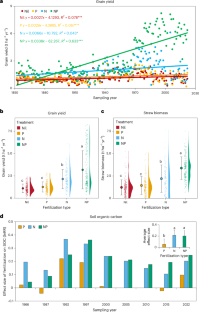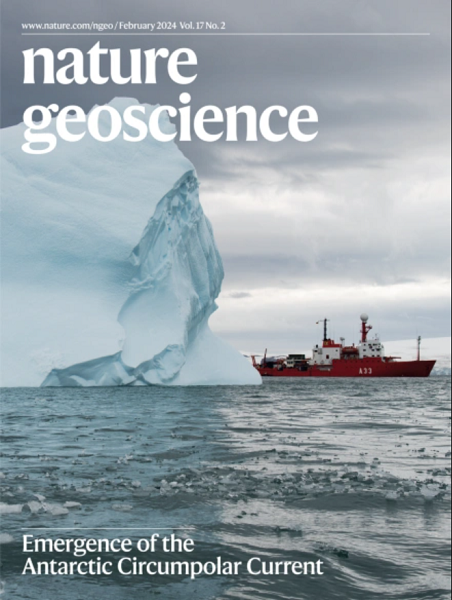长期氮磷肥对土壤固碳的促进作用
IF 16.1
1区 地球科学
Q1 GEOSCIENCES, MULTIDISCIPLINARY
引用次数: 0
摘要
土壤有机碳对减缓气候变化和农业生态系统的可持续性至关重要,但其耗竭令人担忧,其对长期施肥的反应尚不清楚。在这里,我们利用世界上持续时间最长的冬小麦连续施肥试验——英国洛桑研究所的Broadbalk经典试验,以及14C标记、宏基因组学和代谢组学来确定180年的氮(N)和磷(P)施肥如何影响土壤有机碳动态。与不施肥相比,长期施磷肥、氮肥和NP配施分别使土壤有机碳含量提高10%、22%和28%。单独施用磷肥不成比例地增加了微生物呼吸(37%)和生物量(20%),限制了稳定碳的形成,略微增加了不稳定碳。单独施氮增加微生物碳利用和坏死块积累效率,增加矿物相关碳积累。NP配施增加了植物源碳输入和活性碳向稳定碳的转化,增加了土壤有机碳的数量和稳定性。施肥持续时间对土壤有机碳影响的荟萃分析显示,全球范围内施氮和施磷分别增加了21%和13%的农田土壤有机碳,在16年和34年后,这两种促进作用分别先下降后上升。总体而言,长期施用矿肥能有效增强土壤固碳能力。本文章由计算机程序翻译,如有差异,请以英文原文为准。


Soil carbon sequestration enhanced by long-term nitrogen and phosphorus fertilization
Soil organic carbon is crucial for climate mitigation and agroecosystem sustainability, yet its depletion is concerning and its response to long-term fertilization remains unclear. Here we leverage the Broadbalk Classical Experiment at Rothamsted (UK), the world’s longest-running continuous winter wheat fertilization trial, along with 14C labelling, metagenomics and metabolomics to determine how 180 years of nitrogen (N) and phosphorus (P) fertilization impact soil organic carbon dynamics. Compared with no fertilization, long-term P, N and combined NP fertilization increased the soil organic carbon content by 10%, 22% and 28%, respectively. P application alone disproportionately increased microbial respiration (37%) and biomass (20%), limiting stable carbon formation and slightly increasing labile carbon. N application alone increased microbial carbon use and necromass accumulation efficiency, increasing mineral-associated carbon build-up. Combined NP fertilization enhanced plant-derived carbon inputs and the transformation of labile carbon into stable carbon, increasing soil organic carbon quantity and stability. A meta-analysis of the effects of fertilization duration on soil organic carbon revealed that N and P fertilization globally increased cropland soil organic carbon by 21% and 13%, and these promoting effects decreased before increasing after 16 and 34 years, respectively. Overall, long-term mineral fertilization can effectively enhance soil carbon sequestration. Nitrogen and phosphorus fertilization is an effective pathway to increase soil carbon sequestration through microbial necromass accumulation and plant-derived carbon inputs, as shown by a 180-year soil fertilization experiment, 14C labelling, metagenomics and metabolomics.
求助全文
通过发布文献求助,成功后即可免费获取论文全文。
去求助
来源期刊

Nature Geoscience
地学-地球科学综合
CiteScore
26.70
自引率
1.60%
发文量
187
审稿时长
3.3 months
期刊介绍:
Nature Geoscience is a monthly interdisciplinary journal that gathers top-tier research spanning Earth Sciences and related fields.
The journal covers all geoscience disciplines, including fieldwork, modeling, and theoretical studies.
Topics include atmospheric science, biogeochemistry, climate science, geobiology, geochemistry, geoinformatics, remote sensing, geology, geomagnetism, paleomagnetism, geomorphology, geophysics, glaciology, hydrology, limnology, mineralogy, oceanography, paleontology, paleoclimatology, paleoceanography, petrology, planetary science, seismology, space physics, tectonics, and volcanology.
Nature Geoscience upholds its commitment to publishing significant, high-quality Earth Sciences research through fair, rapid, and rigorous peer review, overseen by a team of full-time professional editors.
 求助内容:
求助内容: 应助结果提醒方式:
应助结果提醒方式:


